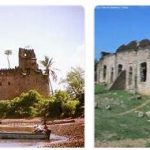The World Heritage includes three national parks around the salty Lake Turkana: The Sibiloi National Park on the east bank is home to lions, zebras, antelopes and gazelles as well as a unique bird paradise for flamingos, pelicans and many other migratory birds. The rocky central island in the lake and the south island about 100 km away are important breeding areas for the now rare Nile crocodiles, for hippos and numerous species of birds. Significant hominid fossils have been discovered in the Koobi Fora paleontological site on Lake Turkana. In 2018, the World Heritage was placed on the Red List due to the construction of a dam on the Omo tributary.
Lake Turkana: facts
| Official title: | Lake Turkana National Park with the Sibiloi Islands (fossil mammal site) and South Island National Park |
| Natural monument: | since 1973 Sibiloi National Park with 1570.85 km² and since 1985 Central Island National Park with 5 km², heights from 340 to 550 m; to be characterized as semi-desert-like habitat, volcanic formations such as Mount Sibiloi and Central Island, as well as remnants of an approximately 7 million year old petrified forest; Paleontological finds at Koobi Fora, north of Alia Bay, including Australopithecus robustus, Homo habilis, Homo erectus and Homo sapiens as well as fossil mammals |
| Continent: | Africa |
| Country: | Kenya, see smber |
| Location: | Eastern shore of Lake Turkana and an island in Lake Turkana, north of Nairobi |
| Appointment: | 1997 |
| Meaning: | important fossil site and one of the most important African breeding sites for crocodiles |
| Flora and fauna: | Mammals such as plains zebra, Grant’s gazelle, oryx, cow and lyre antelope, lesser kudu, lion and cheetah; in the Sibiloi National Park a refuge for the endangered Grevy’s zebras, on Central Iceland breeding ground for an estimated 12,000 Nile crocodiles; 350 species of birds, including on Central Island breeding colony of the brown-mantled scissors-bill, also resting place for pygmy sandpipers |
Traces of early humans on the »Jade Sea«
The sun burns mercilessly from the cloudless sky. The huge black-brown lava fields do not reflect the sun’s rays, but store them, so that even at night any hope of cooling is in vain. The air shimmers and makes it almost impossible to delineate individual animals in the herds of the Boehm and Grevy’s zebras that occur next to each other. The wind, which is as hot as an oven and does not cool down, blows mostly from the west, because the somewhat cooler air over Lake Turkana is powerfully sucked in by the rising air masses over the hot land. You think you can literally hear the heat booming, but it’s your own pulse that pounds in your ears. Even those who have traveled a lot in Africa have to admit that Lake Turkana is one of the hottest and most inhospitable places in Africa.
Despite or perhaps because of these climatic conditions, the national park is very attractive. The view from the semi-desert to the green lake will cast its spell on every visitor. The waves with their white whitecaps stand in stark contrast to the brown mountains on the other bank that disappear in the haze. A clear blue cloudless sky arches above everything, from which a flock of pink flamingos stands out. One is amazed that large animals live here: after all, there are lyre antelopes, gerenuks, billy goats, giraffes, zebras and even lions and some cheetahs.
This remote area was not always so hostile to life. A few hundred years ago the Maasai found good pasture for their cattle here on their way south. Millions of years ago there was even primary forest here, which is still reminiscent of huge petrified tree trunks, the age of which is estimated at seven million years. Back then, our ancestors must have had very favorable climatic conditions. At least that is proven by the extensive excavations that Richard Leakey unearthed in Koobi Fora. As the son of the famous paleanthropologists Louis and Mary Leakey, who found important fossils in the Olduvai Gorge in Tanzania, Richard Leakey was able to shed further light on the history of mankind. It was a sensation when he found an approximately two million year old skull of our human ancestor, Homo habilis, in 1972. In 1999, scientists discovered Kenyanthropus platyops fossils there that are 3.5 million years old. To be able to look over the shoulders of the digging researchers for a few days on site creates thoughtful, downright awesome feelings. In Koobi Fora the question inevitably arises as to what we humans have done to our earth and what we will do with it in the future.
The no-drain Lake Turkana, on whose shallow shores graceful herons, trees, waders and seagulls wade, is the northernmost lake in the East African Trench. Masses of blue-green algae live in its alkaline water, giving the water that fascinating, intense blue-green color that appears almost unreal in the dry, brown-gray semi-desert. The chosen name “Jade Sea” is therefore particularly appropriate and goes back to the Austro-Hungarian Count Samuel Teleki, who reached the shores of what is now called Lake Turkana in March 1888. In the middle of the often very stormy lake are two islands that have been placed under protection as the Central and South Island National Park. Both are of volcanic origin and partly still active. The central island is the most important breeding ground in the world for the endangered Nile crocodiles; it appears oppressively desolate and desolate, an impression that is reinforced by the sulphurous gases during occasional weak volcanic eruptions. The occurrence of venomous snakes, which are particularly common on the Northern Island, increases the hostile impression for us humans. The three small lakes, the flamingo, the crocodile and the particularly green tilapia lake, with their warm water do nothing to change that.





